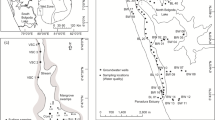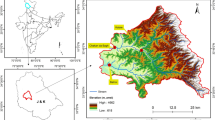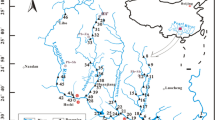Abstract
The effects of prevailing weather on short-term dynamics of certain water quality variables in low-flow conditions were studied in the Ganga river stretch at Allahabad, India. Mean temperature and light intensity showed general diel pattern with significant (p < 0.001) higher values in the afternoon, while significant high rate of change (p < 0.001) was observed in evening wind speed. Total dissolved solids (TDS), total suspended solids (TSS) and turbidity were quite high and displayed a general variable pattern significantly (p < 0.05) associated by evening winds. Wind speed exhibited a significant negative correlation with Chl-a and positive correlation with TSS (r2 = 0.48 and 0.74, p < 0.05, respectively). Afternoon temperatures affected the rate of change of water temperature which was also significantly correlated with dissolved organic carbon (DOC) (r2 = 0.79, p < 0.001). DOC was significantly correlated with the TDS levels (r2 = 0.80, p < 0.001). No correlation existed between average flow (9.50 ± 0.51 m3 s−1) and the tested water quality parameters, while it exhibited strong correlation with the water temperature (r2 = 0.89, p < 0.05). The results indicate that the low-flow conditions during summer may make the river water a complex turbid system where afternoon temperature and evening winds have significant influences on the short-term dynamics and may partially mask the general diurnal patterns of certain water quality variables. The study indicates complex interactions among weather and water quality parameters in low-flow conditions which warrant more elaborative studies. Constant monitoring is recommended to find out an optimum flow to reduce the chances of weather influenced pollution aggravation in this important river stretch.




Similar content being viewed by others
References
Allan JD, Castillo MM (2007) Stream ecology: structure and function of running waters. Springer, New York
Richter BD, Mathews R, Harrison DL, Wigington R (2003) Ecologically sustainable water management: managing river flows for ecological integrity. Ecol Appl 13(1):206–224
Postel S, Richter B (2012) Rivers for life: managing water for people and nature. Island Press, Washington
Kumar N (2014) 3Ps (population, poverty and pollution) and the Pious Poor Ganga. In: Our National River Ganga. Springer, Berlin. pp 307–319
Witthöft-Mühlmann A, Traunspurger W, Rothhaupt KO (2007) Combined influence of river discharge and wind on littoral nematode communities of a river mouth area of Lake Constance. Aquat Ecol 41(2):231–242
Franca MJ, Brocchini M (2015) Turbulence in rivers. In: Rivers—physical, fluvial and environmental processes. Springer, Berlin, pp 51–78
Tripathi A, Tripathi DK, Chauhan DK, Kumar N (2016) Chromium (VI)-induced phytotoxicity in river catchment agriculture: evidence from physiological, biochemical and anatomical alterations in Cucumis sativus (L.) used as model species. Chem Ecol 32(1):12–33
Baborowski M, von Tümpling W Jr, Friese K (2004) Behaviour of suspended particulate matter (SPM) and selected trace metals during the 2002 summer flood in the River Elbe (Germany) at Magdeburg monitoring station. Hydrol Earth Syst Sci Discuss 8(2):135–150
Aftab A, Hanley N, Baiocchi G (2010) Integrated regulation of nonpoint pollution: combining managerial controls and economic instruments under multiple environmental targets. Ecol Econ 70(1):24–33
Hocking GC, Straškraba M (1999) The effect of light extinction on thermal stratification in reservoirs and lakes. Int Rev Hydrobiol 84(6):535–556
Caissie D (2006) The thermal regime of rivers: a review. Freshw Biol 51(8):1389–1406
Rabi A, Hadzima-Nyarko M, Šperac M (2015) Modelling river temperature from air temperature: case of the River Drava (Croatia). Hydrol Sci J 60(9):1490–1507
Smith K (1972) River water temperatures—an environmental review. Scott Geogr Mag 88(3):211–220
Guo X, Cai WJ, Huang WJ, Wang Y, Chen F, Murrell MC, Lohrenz SE, Jiang LQ, Dai M, Hartmann J, Lin Q (2012) Carbon dynamics and community production in the Mississippi River plume. Limnol Oceanogr 57(1):1–7
Edmonds-Brown VE, Copp GH, Majecki JA (2004) Diel patterns of drift by macroinvertebrates in the River Lee (Hertfordshire) during low discharge. Lond Nat 83:145–157
Panigrahy BK, Raymahashay BC (2005) River water quality in weathered limestone: a case study in upper Mahanadi basin, India. J Earth Syst Sci 114(5):533–543
Ugwu AI, Wakawa RJ (2012) A study of seasonal physicochemical parameters in River Usma. Am J Environ Sci 8(5):569
Afanasyev SA, Baychorov VM, Giginyak YG, Letitskaya YN, Usov AY, Solonina OV, Fedotov YP, Yavorskiy VY, Oberemchuk TV (2015) Hydrobiological Characteristics and assessment of the ecological state of trans-boundary watercourses located between the Sozh and Desna rivers. Hydrobiol J 51(5):39–49
Gibson BD, Ptacek CJ, Blowes DW, Daugherty SD (2015) Sediment resuspension under variable geochemical conditions and implications for contaminant release. J Soil Sediment 15(7):1644–1656
Tripathi A, Singh GS (2013) Perception, anticipation and responses of people to changing climate in the Gangetic plain of India. Curr Sci 105(12):1673–1684
Pandey J, Pandey U, Singh AV (2014) Impact of changing atmospheric deposition chemistry on carbon and nutrient loading to Ganga river: integrating land–atmosphere–water components to uncover cross-domain carbon linkages. Biogeochemistry 119(1–3):179–198
Jin L, Whitehead PG, Sarkar S, Sinha R, Futter MN, Butterfield D, Caesar J, Crossman J (2015) Assessing the impacts of climate change and socio-economic changes on flow and phosphorus flux in the Ganga river system. Environ Sci Process Impacts 17(6):1098–1110
Pal DK, Bhattacharyya T, Srivastava P, Chandran P, Ray SK (2009) Soils of the Indo-Gangetic Plains: their historical perspective and management. Curr Sci 96(9):1193–1202
Singh GS, Tripathi A (2013) Changing climate in Indo-Gangetic region of eastern Uttar Pradesh. In: Sharma PR, Yadava RS, Sharma VN (eds) Interdisciplinary advances in geography. RK Books, New Delhi, pp 380–392
Nautiyal P, Verma J, Mishra AS (2014) Distribution of major floral and faunal diversity in the mountain and upper gangetic plains zone of the Ganga: diatoms, macroinvertebrates and fish. In: Our national river Ganga. Springer, New York, pp 75–119
APHA (2005) Standard methods for the examination of water and wastewater, vol 21. American Public Health Association, Washington
Lagomarsino L, Diovisalvi N, Bustingorry J, Escaray R, Zagarese HE (2015) Diel patterns of total suspended solids, turbidity, and water transparency in a highly turbid, shallow lake (Laguna Chascomús, Argentina). Hydrobiolgia 752(1):21–31
Hardy DR (1996) Climatic influences on stream flow and sediment flux into Lake C2, northern Ellesmere Island, Canada. J Paleolimnol 16(2):133–149
Tokeshi M (1993) Species abundance patterns and community structure. Adv Ecol Res 24:111–186
Allan JD (1995) Structure and function of running waters. Chapman & Hall, London
Yin Y, Liu J, Jiang G (2012) Sunlight-induced reduction of ionic Ag and Au to metallic nanoparticles by dissolved organic matter. ACS Nano 6(9):7910–7919
Mercado JM, Sala I, Salles S, Cortes D, Ramirez T, Liger E, Yebra L, Bautista B (2014) Effects of community composition and size structure on light absorption and nutrient uptake of phytoplankton in contrasting areas of the Alboran Sea. Mar Ecol Prog Ser 499:47–64
Ovadnevaite J, Ceburnis D, Canagaratna M, Berresheim H, Bialek J, Martucci G, Worsnop DR, O’Dowd C (2012) On the effect of wind speed on submicron sea salt mass concentrations and source fluxes. J Geophys Res-Atoms, 117(D16201). https://doi.org/10.1029/2011JD017379
Kantzioura A, Kosmopoulos P, Zoras S (2012) Urban surface temperature and microclimate measurements in Thessaloniki. Energy Build 44:63–72
Kessarkar PM, Rao VP, Shynu R, Ahmad IM, Mehra P, Michael GS, Sundar D (2009) Wind-driven estuarine turbidity maxima in Mandovi Estuary, central west coast of India. J Earth Syst Sci 118(4):369–377
Volkmar EC, Henson SS, Dahlgren RA, O’Geen AT, Van Nieuwenhuyse EE (2011) Diel patterns of algae and water quality constituents in the San Joaquin River, California, USA. Chem Geol 283(1):56–67
Zhang Y, Shi K, Liu X, Zhou Y, Qin B (2014) Lake topography and wind waves determining seasonal-spatial dynamics of total suspended matter in turbid Lake Taihu, China: assessment using long-term high-resolution MERIS data. PLoS ONE. https://doi.org/10.1371/journal.pone.0098055
Simon TP, Worden SL, Morehouse R (2011) Diel patterns of dissolved oxygen and select chemical parameters in three lakes within Hoosier National forest that have experienced recent fish kills. Proc Ind Acad Sci 120(1/2):45–51
Kumar VB, Kumar VK (2011) Diurnal variations of physico-chemical properties and primary productivity of phytoplankton in Bheema river. Recent Res Sci Technol 3(4):39–42
Tiwari M, Ranga MM (2012) Assessment of diurnal variation of physico-chemical status of Khanpura Lake, Ajmer, India. Res J Chem Sci 2(7):69–71
Vineetha G, Jyothibabu R, Madhu NV, Kusum KK, Sooria PM, Shivaprasad A, Reny PD, Deepak MP (2015) Tidal influence on the diel vertical migration pattern of zooplankton in a tropical monsoonal estuary. Wetlands 35(3):597–610
Monteith DT, Stoddard JL, Evans CD, de Wit HA, Forsius M, Høgåsen T, Wilander A, Skjelkvåle BL, Jeffries DS, Vuorenmaa J, Keller B (2007) Dissolved organic carbon trends resulting from changes in atmospheric deposition chemistry. Nature 450(7169):537–540
Porcal P, Dillon PJ, Molot LA (2015) Temperature dependence of photodegradation of dissolved organic matter to dissolved inorganic carbon and particulate organic carbon. PLoS ONE. https://doi.org/10.1371/journal.pone.0128884
Cozzi S, Reisenhofer E, Di Monte L, Cantoni C, Adami G (2008) Effect of environmental forcing on the fate of nutrients, dissolved organic matter and heavy metals released by a coastal wastewater pipeline. Chem Ecol 24(2):87–107
Ramaraj R, Tsai DD, Chen P (2013) Chlorophyll is not accurate measurement for algal biomass. Chiang Mai J Sci 40(1):1–9
Acknowledgements
AT acknowledges to The National Academy of Sciences India (NASI), Allahabad, for providing ‘Ganga Research Fellowship’. Authors thank to the institutional and laboratory support of the Institute of Applied Sciences, Allahabad, and University of Allahabad, Allahabad, India.
Author information
Authors and Affiliations
Corresponding author
Additional information
Publisher's Note
Springer Nature remains neutral with regard to jurisdictional claims in published maps and institutional affiliations.
Rights and permissions
About this article
Cite this article
Tripathi, A., Kumar, N. & Chauhan, D.K. Weather Correlated Short-Term Dynamics in Certain Water Quality Parameters of the Ganga River in Low-Flow Conditions. Proc. Natl. Acad. Sci., India, Sect. A Phys. Sci. 90, 677–687 (2020). https://doi.org/10.1007/s40010-019-00632-5
Received:
Revised:
Accepted:
Published:
Issue Date:
DOI: https://doi.org/10.1007/s40010-019-00632-5




